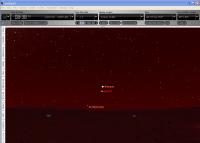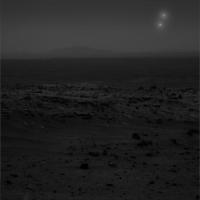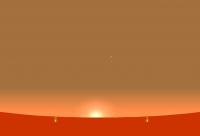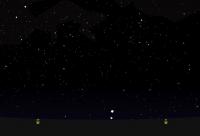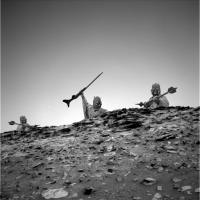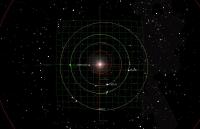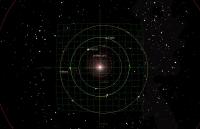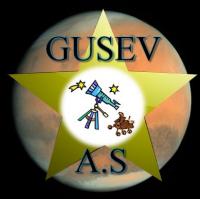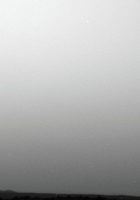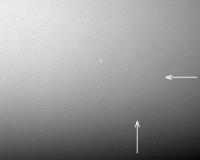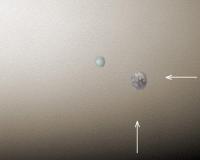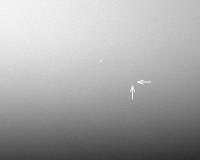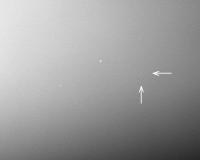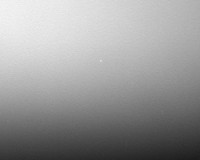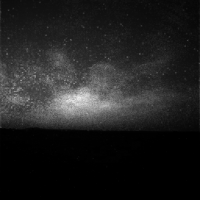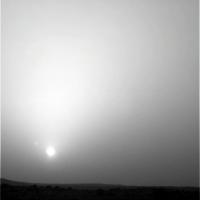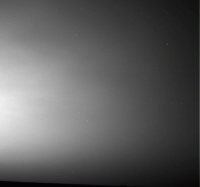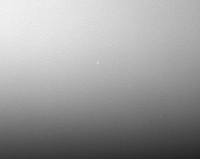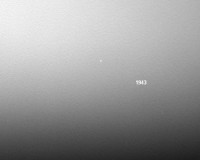Printable Version of Topic
Click here to view this topic in its original format
Unmanned Spaceflight.com _ Spirit _ 800Whrs+ Staying Up Late ideas
Posted by: djellison Jun 6 2009, 07:04 AM
With Spirit producing an annoyingly large amount of power given her current predicament, the time may well have come to re-open the Gusev astronomy society. Anyone have any dusk / nightime observation ideas?
Posted by: Astro0 Jun 6 2009, 07:20 AM
Thinking ahead...
- A low sun angle view of the road ahead towards vonBraun.
There might be some interesting detail to observe with single- and multi-filter observations.
- A second Gusev Sunset image would be nice (I don't think Tsiolkovsky is in the way).
Just a cool image to take.
- Long shadow view back towards Husband Hill in multi-filters.
Just to make up for the version UMSF worked on in what seems like years ago (hey it was!)
- Phobos / star occultation
- MGS star-trail? It's gotta be somewhere!
- MODY / MEX star-trail? Just to be cool.
- Pancam view of an Earth / star occultation (would it be possible?)
I've got no idea what the MERs capabilities are as an observatory, but these are my two cents worth.
Posted by: James Sorenson Jun 6 2009, 08:40 AM
I'm not sure if this would work, and is probably very remote, but what would be cool is to try and capture images of the localized UV aurora's that MEX detected. Does anyone know if Pancam could be sensitive or be even able to detect these? would long exposures with L7 work or would there be to much noise and CR hits?
Posted by: climber Jun 6 2009, 09:37 AM
From my place (here on Earth) I'm able, with dark skies, to see the Zodiacal light. I wonder if Sprit can try this. I don't think she need a too long exposure.
As the pannels are clean, try to get some star reflexions. Could this help for tau detection?
MI image underneath at sun set.
Posted by: Stu Jun 6 2009, 10:01 AM
If my STARRY NIGHT is set up right, then Earth is in the sunset sky at the moment, very close to Venus, with Mercury beneath them...
Good photo op? I haven't got time right now to do a mock-up of what the view would look like, but I'm sure it would look beautiful.
I second all Astro0's suggestions, especially the "long shadows" shots, just because they'd be beautiful pictures...
Posted by: akuo Jun 6 2009, 10:38 AM
An extended sunset movie would be nice with colour filters. So long preferably that the twin evening planets would appear and maybe the brightest stars.
Posted by: ngunn Jun 6 2009, 11:28 AM
I'd like them to scan the dark sky at each end of the night to look for very high level 'noctilucent' clouds, or indeed any clouds that may be around by night but not by day.
Posted by: Stu Jun 6 2009, 12:36 PM
Just for fun... this is inaccurate in countless (tho I'm sure someone will count them! ![]() ) ways, just a pretty picture... I'd love to see the view, that's all...
) ways, just a pretty picture... I'd love to see the view, that's all...
Colour version here http://stugallery.files.wordpress.com/2009/06/sunset1e-s.jpg
Posted by: Tesheiner Jun 6 2009, 01:02 PM
Good photo op? I haven't got time right now to do a mock-up of what the view would look like, but I'm sure it would look beautiful.
I'll second that! Now, if someone could check if the line of sight is clear on that direction...
Posted by: SpaceListener Jun 6 2009, 04:55 PM
I have already checked with the http://space.jpl.nasa.gov and it shows that during the Mars sunset will look Venus and Earth very close and Mercury will be a little farther than them. My wish-list is to take many pictures samples during the noon in order to make a movie of Dust Devil.
Posted by: nprev Jun 6 2009, 05:10 PM
Still think it would be worth staring at appropriate patches of sky an hour or two after/before sunset/sunrise every sol for a few weeks in a row to try to recover any of the defunct orbiters. Should be able to find them, & then identify them by their inclinations (which shouldn't have changed much if at all over the years).
What almost certainly did change for all of them is their orbital radii & therefore their periods, and most of this would be due to times of increased atmospheric drag. This is an aspect of the LMO environment that hasn't been studied over a prolonged span. Mariner 9, the Vikings, and the 70s Soviet Mars orbiters could provide some interesting data in this regard, which in turn could lead to better modeling of the thermal response of Mars' upper atmosphere to solar effects, albedo changes due to dust storms, etc.
Posted by: fredk Jun 6 2009, 06:03 PM
I agree that recovering an orbiter would be very important, but check http://www.unmannedspaceflight.com/index.php?s=&showtopic=5999&view=findpost&p=141160
In terms of imaging Venus-Earth, does your planetarium software tell you their elongation from the Sun? That's the big question, since it determines how bright the sky will be when they're up.
In terms of UV aurora, L7/R1 transmit almost nothing below 400 nm, so those auroras would have to extend into the visible.
I agree low sun angle shots would be great to have, revealing a lot about topography (and looking spectacular too). And low sun movies even more so.
Zodiacal light would be great too, but probably hard. If I recall right, the sky stays bright very long after sunset due to all the dust in the air. But then we could characterize precisely how long the sunset glow is visible by taking a long time series until it's completely dark. That would tell us something about dust high in the air, presumably. Another factor in this is the currently low tau, which would help nighttime observations generally.
Finally, in the almost-certainly-of-no-scientific-value-but-extremely-cool category, I would love to see a 4x1 navcan panorama time series, extending from Grissom Hill to Husband Hill, and starting just after dark in the early morning and running every 10 minutes or so until a while after sunrise. Imagine the first glimmer of the morning Sun on Grissom, and then eventually the shadows of the Columbia Hills receeding towards us from across the plains, and finally the sunlight striking Tsiolkovsky and West Valley.
Posted by: nprev Jun 6 2009, 07:36 PM
Oh, yeah; I remember. Given that we have a such a surfeit of power & a fixed locale for now, though, it seems like one of the most (potentially) scientifically productive options for evening operations. Definitely a very long shot, of course.
One question for anyone who might know: What would be the eclipse durations for any of the defunct orbiters at their last known 'altitudes'? It's just past equinox, and I'm trying to figure out in my head what (if any) the effects would be on spacecraft illumination vs. local astronomical twilight for Spirit; suspect that it's minimal due to her tropical latitude.
Posted by: Deimos Jun 6 2009, 07:44 PM
Keep the ideas coming. Not surprisingly, many of these are being considered. I'll keep some of my own quiet for now ![]() . The weekend plan does contain the beginning of a twilight characterization, with a 20-pair movie starting in the moments before sunset. It won't continue until Venus and Earth are in the frame, but a later instance should get this. These will be similar to the Pathfinder pre-dawn cloud images in some ways, but the filters are chosen for ability to constrain interesting parameters rather than for pretty pictures (although the latter may be doable for those so inclined). Earth will be iffy, Venus should be fine, Mercury-no. Earth, Venus and Jupiter have all been imaged before, of course, and always in the twilight.
. The weekend plan does contain the beginning of a twilight characterization, with a 20-pair movie starting in the moments before sunset. It won't continue until Venus and Earth are in the frame, but a later instance should get this. These will be similar to the Pathfinder pre-dawn cloud images in some ways, but the filters are chosen for ability to constrain interesting parameters rather than for pretty pictures (although the latter may be doable for those so inclined). Earth will be iffy, Venus should be fine, Mercury-no. Earth, Venus and Jupiter have all been imaged before, of course, and always in the twilight.
http://www.space.com/scienceastronomy/mars_earth_040311.html
http://pancam.astro.cornell.edu/pancam_instrument/projects_3.html
Spirit needs to use energy at night to avoid overheating when using (even shunting) the same energy during the day and to keep getting good battery data. So there is a reason for a specific night focus (not that noon dust devil movies are a bad thing). The parameters are not clear (to me), and there will be some exploratory stuff (heating tests...). But last time we did this, we were limited to 20-30 minute chunks most of the time. It is time dependent, but the rovers can use energy quickly when active at night.
Zodiacal light is a no-go. There will not be dedicated orbiter imaging (I expect), but preliminary plans for "nighttime opacity" imaging make it multi-purpose, with one consideration being to maximize utility in the event of a serendipitous detection. But since we missed ODY's trail when we know where ODY was, I'm not optimistic. The UV aurora idea is also a no-go, but there are other similar if still unlikely possibilities.
I imagine things with more compelling science rationale will be done first, but other factors may influence the timing (some times of night are more accessible than others). I've scoped out a sunset mosaic, but am not planning to push it just yet. It won't beat the 489 mosaic in artistic merit. If you look at the Calypso pan in the "unstuck" thread and work left from Husband Hill to the first rock that juts up, sunset should be a be less than a frame left of there (from memory, not my notes).
Oh, and we just missed a real good near-occultation of a bright star by Phobos (Phobos moves too fast to really show an occultation with Pancam).
Posted by: Stu Jun 6 2009, 07:59 PM
Some number crunching on the Earth image... hopefully it won't be too "iffy"!
Ok, so at sunset Earth will be 28 degrees away from the Sun...
Earth will set approx 2 hours later...
(just wondering why Earth should be iffy..? It's not going to be an awful lot fainter than Venus..?)
Using an old version of STARRY NIGHT here so please, no scolding if this isn't 1000% accurate...
Posted by: Fran Ontanaya Jun 6 2009, 09:16 PM
Is there any chance of detecting triboluminescence (see http://www.nature.com/nature/videoarchive/x-rays/) under the wheels if she attempts to move at night?
Posted by: akuo Jun 7 2009, 03:47 PM
Would it be technically possible to track the Martian sky with the motors in the mast? This would allow long exposures of star fields :-)
Posted by: tasp Jun 7 2009, 08:22 PM
The triboluminesence idea got me thinking, with the low humidity, does the wind, when it moves the dust around, create static charges ?? And if there is a wind gust in the night would it release enough visible light in the dust to show in a long exposure ?? {I assume we know for sure there are no dust devils at night, but how about wind gusts ?}
Posted by: Fran Ontanaya Jun 7 2009, 09:13 PM
http://science.nasa.gov/headlines/y2005/14jul_dustdevils.htm
Posted by: Oersted Jun 8 2009, 12:59 AM
How fast can they take consecutive images? Would be nice to have a max. speed sequence, an *almost* movie, hopefully with a dust devil in it...
Posted by: CosmicRocker Jun 8 2009, 05:54 AM
The L7 and R1 filters are high-pass filters, which I thought, should pass all wavelengths shorter than the nominal cutoff. The L1 slot, which contains no filter, should also allow UV wavelengths through to the detector.
Posted by: climber Jun 8 2009, 12:54 PM
Please check this and tell me if you can see "stars" in the upper left of the pictures: http://qt.exploratorium.edu/mars/spirit/navcam/2009-06-08/
Actually, I can see 3 "stars" about the same position on different pictures and another 2 more on the right on two other pictures.
May be I'm seeing what I want to see and they are artifacts.
Posted by: djellison Jun 8 2009, 12:59 PM
We've mentioned this many times before. Check the right and left eye. Compare them. If you think you've seen a 'star' or 'meteor' or something else....find the matching eye. For it to be a REAL object, it must be in BOTH images.
In this case - there are no similar star like features in both the right and left eye.
Posted by: Astro0 Jun 8 2009, 01:00 PM
I'd be more interested in something that appears in this image...
http://qt.exploratorium.edu/mars/spirit/navcam/2009-06-08/2N297706508EFFB1DQP0853R0M1.JPG
Just above HP to the lower left of image.
Haven't noticed an effect like that before.... ideas?
Posted by: djellison Jun 8 2009, 01:25 PM
A hot pixel with added pixel bleed?
Posted by: ElkGroveDan Jun 8 2009, 01:31 PM
I don't believe that hot pixels "bleed" the way overexposed ones do. Perhaps a cosmic ray particle.
Posted by: Stu Jun 8 2009, 01:33 PM
If I was Spirit I'd be keeping a close eye on the top of Homeplate too...
Posted by: Deimos Jun 8 2009, 01:40 PM
The "fast" dust devil movie gets 3 sec per frame at first, before slowing down. Less optimized imaging can be done at 10, or more normally 20 second spacing. Going faster requires other tradeoffs.
These CCDs have little UV response. L1 in particular would emphasize longer wavelengths even if there were UV sensitivity (ie, you might know you 'discovered' something but not know if it is zodiacal light, a dust riung, IR airglow, UV aurora, etc.).
No, the mast precision is large compared to the typical star-trails.
Earth is 1.6 magnitudes fainter in a clear sky. With current dust levels, I'd guess we won't see much until the Sun approaches 10-15 deg below the horizon. At those angles (E+V 15 deg up) the few extra deg up for Venus translates into another magnitude or two. My hunch is there is a narrow window about 50-75 minutes after sunset for Venus, with the best chance for Earth on the early side of that window. We'll see. (A couple years ago I could have been quite precise; my notes aren't that good.)
Posted by: Deimos Jun 8 2009, 01:50 PM
Hot pixels will bleed when they accumulate enough DN, leaving what looks like a small blob with impossibly narrow tails. The pixels in question do indeed look like a cosmic ray, though.
Posted by: CosmicRocker Jun 8 2009, 02:27 PM
Posted by: djellison Jun 8 2009, 02:34 PM
MER CCD response is in this paper
http://pancam.astro.cornell.edu/pancam_instrument/doc/Bell_Pancam_JGR.pdf - Pg 13.
Posted by: Stu Jun 8 2009, 04:13 PM
Playing about with STARRY NIGHT again just now I found that the magnitude of Earth on March 8th, 2004, when the famous "Pale Dot in the sky" image was taken ( http://solarsystem.nasa.gov/multimedia/gallery/Mars_to_Earth.jpg ) was -2.37. Earth's magnitude at the moment is -2.2, so hopefully Earth should be bright enough to be recorded on an image now, too..? I know it won't be a priority, but I'd love to see it! ![]()
Posted by: fredk Jun 8 2009, 04:24 PM
Stu, can you find out what our elongation from the Sun was then? Looking at the current solar system layout, we're not too far from greatest elongation right now, which is a nice coincidence.
The other factor is dust. I don't know if we can find out what the tau was at that time, but I'm sure dust would have a big impact on visibility.
Posted by: fredk Jun 8 2009, 05:59 PM
Thanks Stu. I get around 29 or 30 degrees elongation now versus 35 or so then.
But it's getting steadily better. Fiddling around with the solar system simulator, I very roughly estimate that greatest elongation will be in September, at something like 38 degrees.
Posted by: Deimos Jun 8 2009, 06:33 PM
Dust opacity was actually higher then, but Earth was 8.5 deg higher in the sky for the same solar depression angle. Roughly, I get a 35% fainter Earth and actually an even fainter sky. So, more than "iffy", even thought the filters won't be as sensitive as for that image. In any case, some images are on the agenda. They are not optimized specifically for planet hunting, but they are aimed so that's a bonus (and you'll see little Earth trails...). Aside: an RGB set could be quite fun in a couple weeks when E & V are at their closest, but it will still be close to Earth's current altitude.
Posted by: Stu Jun 8 2009, 06:51 PM
Oh, just click away, you'll get something. It's not as if you're wasting film! ![]()
Seriously tho, Deimos, I really appreciate the comments on this. I know that if you manage to capture it, Earth will just be a spot of light but... well... come on, EARTH, shining in the sky on Mars... it doesn't get a lot cooler than that. ![]()
And the Outreach value of such images, even less than perfect ones, simply cannot be over-stated. I gave a talk to a Womens' Institute last week, deep in the South Cumbrian outback, and part of my "Tour of the Universe" is a zoom-out from Earth to see how it shrinks and changes in apearance, using views from orbit, the Moon and of course Mars. The images of Earth taken by Kaguya always go down well, but they're familiar in that they look like better quality versions of well-known Apollo images. The Cassini image of Earth shining through a gap in the rings goes down well too, but takes quite a lot of explaining. Ah, but that image of Earth shining in Mars's sky... everyone at the talk had seen Venus shining after sunset as an Evening Star, so they found it easy to grasp the concept that Mars' evening star is often Earth... During the Mars section of my talk I always show an artist's impression of what Earth would look like in the sky from Mars, as a teaser, so when the real pic comes up on the screen later the response is always, always, "Wow... look at that... that's beautiful..."
So go for it. Anything you get will be great!
Posted by: marswiggle Jun 8 2009, 11:08 PM
I don't have any parameters at hand, but I suppose also a rising (tiny) crescent Phobos could be caught in the west some time after sunset?
Posted by: Pertinax Jun 9 2009, 01:47 AM
So much of the low and even middle hanging fruit has been picked, and my tired brain has not conspired with me to conceive of any higher fruit -- yet -- that I will plug my favorite out of the ideas Astro0 borrowed from my brain....
Just to make up for the version UMSF worked on in what seems like years ago (hey it was!)
Would a 5x1 or even a 5x2 pancam 3,5,7 or 4,5,6 or such panorama be feasible between Tsiolkovsky and Husband Hill at a low sun angle (~~15 Deg or less)? My concern would be that too much time would elapse between filter sets making near shadows fringed with little rainbows. If feasible, my deeper dream would be a series at say 5 degree solar elevation angles (say 20, 15, 10, and 5) -- only 120 pancam frames!
-- Pertinax
Posted by: akuo Jun 9 2009, 08:12 AM
That's interesting. I would have thought the motors are "ultra-precise", but I guess pointing accuracy was also a problem with Phoenix. What sort of accuracy do you have with pancam pointing after a slew, arc-minutes, degrees? How much marginal do you leave in Pancam images to count for pointing errors? Thanks.
Posted by: Deimos Jun 9 2009, 03:34 PM
The MER PMA points much more precisely and accurately than the Phoenix SSI. Accuracy is a good thing, but precision is not really needed--for navigation, you are just trying to get the right 14-45 deg field of view. I forget the exact numbers for the PMA (*) but I think it's in the few arc-minute range (driven by MTES 8 mrad stares, as far as I know).
(*) for PHX/SSI, pointing was generally in motor steps, leading to intimate knowledge of the step-angle relation. For MER, pointing is typically in radians with conversions done on board.
Posted by: climber Jun 17 2009, 08:39 PM
From Scott Twitter: Amazingly, we're planning *overnight* observations on Spirit. We've got *that* kind of energy. Stay tuned for PANCAMs of the night sky
Posted by: Deimos Jun 19 2009, 12:53 AM
Yes, we've gotten some nice twilight imaging (not spectacular, but model-constraining). We have planned an observation that I dug out of email (original subject: "Spirit sol 706A or 707A night-time opacity") from when our previous glory nights came to an end, as well as some other star imaging for night opacity. And of course there are a few goodies in the pipeline... The twilight images are only down in thumbnail form, and unfortunately had to be downsampled; but you still might recognize a couple of the pixels.
Posted by: Stu Jun 19 2009, 05:19 AM
You big tease! If those pixels aren't Earth and Venus after you've said that I'm going to be seriously frakked off!
Looking forward to the big pix!
Posted by: jamescanvin Jun 19 2009, 07:57 AM
Here is one of those thumbnails

Working on movie...
Posted by: jamescanvin Jun 19 2009, 08:14 AM
Movie of twilight at Gusev, taken over 23 minutes at around 18:30LST on Sol 1835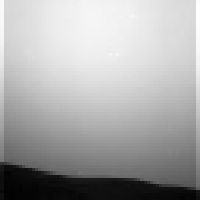
Are we seeing stars and Earth/Venus or are those just hot pixels - I'm a little surprised that there is no apparent movement as they set.
Posted by: Oersted Jun 19 2009, 09:24 AM
Phobos and Deimos maybe? I seem to see two dots that move from right to left.
Posted by: fredk Jun 19 2009, 02:19 PM
I think they're all hot pixels/CR's. Nearish the celestial equator, stars would move about one pancam-field per hour, so roughly a third of a field in the 23 minutes of this movie. It would be less if we're looking near a pole. What's the azimuth of this view?
Posted by: Deimos Jun 19 2009, 03:28 PM
These views are just right of sunset, a bit south of west. Earth and Venus set in the frame, but I can't make them out in the thumbnails (nor did I expect to). There are plenty of hot pixels in the long exposures, and the occasional cosmic ray strike. Phobos rises and Deimos sets to the right of this field and weren't in that direction at this time.
Posted by: Stu Jun 23 2009, 08:50 PM
Latest navcams ( http://qt.exploratorium.edu/mars/spirit/navcam/2009-06-23 ) are of twilight scenes, but there's so much crud on them (made an animation but not even going to bother posting it, it looks like a firefly party!) I can't pick anything out of the mess. Maybe others can do better.
Posted by: fredk Jun 24 2009, 12:54 AM
Some pancams show a bright star (moon?) and a fainter one, see the trails in, eg, this frame:
http://qt.exploratorium.edu/mars/spirit/pancam/2009-06-23/2P298897760ESFB1E5P2738L1M1.JPG
Another pancam series at dusk shows one clear star-like point setting from frame to frame, so it's not CR/hot pixels. Check out the upper quarter of the frame in this animated gif:
My guess is Venus
Posted by: Stu Jun 24 2009, 06:53 AM
Good catch Fred, definitely something there.
Posted by: Astro0 Jun 24 2009, 07:03 AM
Moon or spacecraft? (and by that I mean "one of our spacecraft")
Animation...
Nice to see the Gusev Astronomical Society active again
Posted by: djellison Jun 24 2009, 08:13 AM
Phobos going into eclipse, I'd say. (Although not actually IN eclipse at that point)
Posted by: fredk Jun 24 2009, 02:39 PM
I'll go out on a limb and guess the bright object in Astro's animation is a star. I get a motion of around 140 degrees per sol for it, which is nowhere near what you'd get for either moon, and much too slow for an orbiter, but would match a star at mid-celestial latitude. I've assumed the frames are not downsampled, just subframed.
Posted by: mhoward Jun 24 2009, 03:32 PM
Really cool stuff. FWIW the images in fredk's animation are labeled "pancam_earth_venus," and the images in Astro0's animation are in the southern sky about 38 degrees above Von Braun, and are labeled "pancam_nighttime_opacity".
Posted by: Deimos Jun 24 2009, 09:06 PM
The star is Canopus, which is not quite circumpolar from Gusev. It looks wide in the images only because of the extreme contrast stretch. Earth is to the lower right from Venus (about 2 deg) in the twilight animation--but it is so low contrast I'm not sure if it can be seen in the jpegs. It should become clearer over time.
Posted by: fredk Jun 24 2009, 10:46 PM
I registered the 5 Venus-Earth pancam frames on Venus and then averaged them to try to cut down the jpeg noise. Here's the result:
One pale grey dot stands out above the noise, about 1.5 degrees to the lower right of Venus (at intersection of arrows). If you look very closely at the five individual frames, you can see it in each, so it's not a bright CR hit in one frame, and it's not a hot pixel, since they move relative to Venus (you can see some towards the bottom of the frame).
Going out on another limb, I say that dot is Mother Earth.
Posted by: helvick Jun 25 2009, 06:36 PM
Nice work there Fred, very nice.
Posted by: Stu Jun 25 2009, 06:54 PM
If that is Earth, you're my new hero Fred. ![]()
Posted by: ilbasso Jun 25 2009, 09:11 PM
I'm waiting for the MERs to start spamming each other with:
Earth Spectacular
Check it out, guess no one will get much sleep in August.
Earth
The Blue Planet is about to be spectacular!
This month and next, Earth is catching up with Mars in an encounter that will culminate in the closest approach between the two planets in recorded history.
The next time Earth may come this close is in 2287.
At a modest 75-power magnification Earth will look as large as the Phobos to the naked eye.
Share this with your children and grandchildren.
NO ONE ALIVE TODAY ON MARS WILL EVER SEE THIS AGAIN
Posted by: SFJCody Jun 25 2009, 09:35 PM
A nice update http://www.jpl.nasa.gov/news/news.cfm?release=2009-102.
Posted by: CosmicRocker Jun 26 2009, 05:00 AM
Share this with your children and grandchildren.
NO ONE ALIVE TODAY ON MARS WILL EVER SEE THIS AGAIN
Hehe! LOL.
Thanks for posting that, SFJ. I had gotten out of the habit of watching the main JPL site, and would have missed it if you hadn't provided the link. That was one of the more informative news releases from the Rovers in recent times. I really like to hear about some of the scientific speculations going on behind the scenes, and that piece contained quite a bit more than we normally see. It really should have been linked to on the main Rover site. Ever since Tyrone I have been wondering about the color hues of these deposits, and whether or not they pre- or post-date Home Plate.
Posted by: Stu Jun 26 2009, 06:48 AM
Do we have any confirmation yet that the two dots in Fred's image are indeed Venus and Earth? I'd love to show that image in an Outreach talk I'm giving tonight if they are...
Posted by: Deimos Jun 26 2009, 12:06 PM
Stu: Yes. And there are more images from this series on the ground from the AM pass. There's not a bright star to register to, but what you might see is Venus moving closer to the Sun, Earth farther, and the two passing each other.
Posted by: fredk Jun 26 2009, 03:50 PM
Thanks for that Dan! Amazing what the right software can do to pull details out of an image. ![]()
The new batch from 1943 and 1945 show Earth as well, as Deimos said. Here are the views on these two sols, again all five pancam frames registered on Venus and averaged:
If I saw the 1943 frame alone, I'd never have made the identification, but when you look at the movement of Earth in the other frames, that's where Earth has to be on 1943.
And Stu, perhaps you could even show this animation, showing the movement of Earth relative to Venus over three Martian nights:
Posted by: PDP8E Jun 27 2009, 03:00 AM
WOW
< speechless >
Posted by: CosmicRocker Jun 27 2009, 05:57 AM
Nice work, fredk; but would you mind redoing them with EGD's enhancements? ![]()
Posted by: Fran Ontanaya Jun 30 2009, 05:45 AM
Five recent navcams, averaged and blended using the difference mode.
Posted by: Astro0 Jun 30 2009, 02:53 PM
Thought I'd play around with an enhancement on the sunset images from Sol1940.
20sec movie sequence....
 Spirit_Sunset.wmv ( 872.77K )
: 3642
Spirit_Sunset.wmv ( 872.77K )
: 3642It's been a while since we've seen one of these...beautiful!
Posted by: climber Jun 30 2009, 03:37 PM
Beautifull indeed! Do you know why it seams that the light increase during the first seconds then decrease as it should?
Posted by: ugordan Jun 30 2009, 05:33 PM
Automatic contrast stretch, I'd say.
Posted by: alan Jul 1 2009, 02:14 AM
I believe the short streak on the right is Phobos.
http://207.7.139.5/mars/spirit/navcam/2009-06-30/2N299595404EFFB1E5P1901R0M1.JPG
Posted by: fredk Jul 1 2009, 04:18 AM
I believe you're right.
Animation of Phobos rising in the west on sol 1951:
Posted by: nprev Jul 1 2009, 04:53 AM
Great animation, Fred!
It gave me another possible evening app idea. Looks like some of those streaks just might be sporadic (random non-shower) meteors. On Earth, due to a number of factors including season & time of day, the average rate at any locale is anywhere from 2 to maybe 20 per hour across the entire visible sky. I'm certain that we have no data at all about the rate of sporadic meteor occurrence anywhere else in the Solar System.
The rate of sporadics is highest just before sunrise as the piece of Earth or Mars you happen to be on faces the direction of the planet's orbital motion around the Sun. It could be well worth while to execute a predawn observation campaign for as many days as we can to get a rough meteor count. Might even get lucky & identify a Martian meteor shower or two!
Posted by: Astro0 Jul 1 2009, 09:54 AM
fredk - fantastic animation.
What I love are the clouds that are catching the evening light.
Posted by: Deimos Jul 1 2009, 01:37 PM
The streaks are just cosmic rays. Most CRs are small splotches, but these long exposures are enough to catch several at glancing incidence. If the navcam frames had actual meteors, the pancam L1 frames would be chock full of them--and the incidence of streaks in pancam and navcam is about the same. In fact, in the whole meteor search last time we had this kind of power, streaks were just as common in "dark" filters as in the clear filter. I've heard some analysis suggests we need to repeat 2005s observations 10x to have an expected value of 1 meteor, given camera sensitivities. So we'd need >100 2005s to get statistics. So, maybe no surprise that "meteor search" hasn't been showing up at the tracking data base. (Of course, when possible, stereo exposures are used and the exposure time is slightly offset so there's a chance one will be spotted and give speed and direction info--as long as that doesn't interfere with other objectives.)
Posted by: Fran Ontanaya Jul 1 2009, 05:37 PM
Is there any chance to bounce a radio signal on them from one of the satellites and listen it with Spirit? Since the martian atmosphere is so thin, I guess that the ionized tails would be closer to the ground.
Posted by: helvick Jul 1 2009, 07:00 PM
IIRC despite being much thinner at the ground Earth and Mars atmospheric density are pretty close at the altitudes where the bulk of meteors burn out - Mars lower gravity means the scale height is ~11km vs 6-7km for Earth. I ran the numbers sometime back but can't find them now unfortunately but I'd be very surprised if Martian meteors were generally burning up at significantly lower altitudes than on earth. There are further complications of course, most of the source "debris" will be slower relative to Mars than similar material impacting Earth's atmosphere and that might mean that it can penetrate lower (having less energy to burn through).
Posted by: CosmicRocker Jul 2 2009, 04:46 AM
I was about to bemoan your depiction of CRs as "small splotches,"
but then, the above comment attracted my attention.
I didn't know there was a time offset between the stereo images. Since the time stamps in the file names of all stereo pairs I've noticed have been identical for the L and R images in each pair, I assume this offset is less than one second. Can you elaborate on this a bit? Is the offset a constant? Is it the same value for each of the camera pairs? If it is a constant, can you tell us its value?
...Thanks
Posted by: Deimos Jul 2 2009, 03:13 PM
Sometimes the science objective requires exposures that don't help--like 10 sec L1s with 60 sec R4 or other (not to mention single eye imaging). But a common strategy is to start exposures at the same time and have one eye use a 61 sec exposure and the other use 60 (or similar 1-sec offset). So, odds are (in decreasing order) no meteor is seen; one is seen only in L1; one is seen in both with no obvious staggered end point; one is seen in each, and the end points project to different points of the sky. The last, of course, would imply the meteor was in the FOV at the end of the exposure (since start time is the same), and would show motion direction and show how much motion occurred in the last second. Low odds of success-but frequently, no cost to doing. So much of the 2005 meteor campaign used this. (generally, the right eye would get the extra second, but that's not a rule or anything.)
Posted by: nprev Jul 3 2009, 02:08 AM
Okay, longest long-shot goofball night obs idea I can conjure up: Aurora search.
IIRC, Mars' magnetic field (what there is of it) is localized & kind of fragmented as surface remnants of its primeval core source field, so there's no real N-S mag poles like Earth. Still, the upper atmosphere must fluoresce (sp?) however weakly sometimes; long horizon exposures in the dead of night (which look through the longest chord of the atmosphere possible) might reveal occasional transient glows.
Alternatively, maybe we might pick up the occasional flash of a static discharge from airborne dust? This might even be somewhat reasonable; presumably airborne dust clouds from DDs, gusts, etc. begin to descend at night once solar heating ceases, so they might zap the ground on the way down.
<waits for waves of derisive laughter, some of which he himself emits!>
Posted by: BrianL Jul 3 2009, 04:20 AM
Oh, not even remotely in the goofball night obs game. Two words: nocturnal life forms. OK, three words.
Posted by: lyford Jul 3 2009, 03:58 PM
Since MRO has taken a few shots of Spirit, is it even possible that she return the favor?
Posted by: Astro0 Jul 4 2009, 02:15 PM
Here's a movie of the sunset on Sols 1940 and 1954.
A little music and colourisation added for effect. Enjoy ![]()
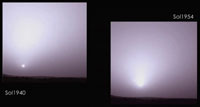
 Mars_Sunsets.wmv ( 2.49MB )
: 637
Mars_Sunsets.wmv ( 2.49MB )
: 637
Posted by: imipak Jul 4 2009, 06:19 PM
Well now, if we're talking goofball ideas... Astro0's evocative animation of the sunset especially reminds me that I've often wondered about the outreach potential of full-motion video. Of course, there are plenty of excellent reasons why video capture's not a requirement for present or any future lander, not least the fact that if nothing much moves... what do you film?
Well, actually quite a few things move or change their appearance relatively quickly. (That's evident from the many amazing animations posted here and elsewhere composed from still sequences.) The sun moves, of course, and the shadows cast by the landscape and rover itself. Those planets which are bright enough to be visible (more slowly.) The stars, and possibly other astronomical objects. Phobos and Deimos. Possibly orbiting spacecraft. Dust devils. Atmospheric phenomena - clouds, and dust clouds; possibly aurorae as suggested by nprev above. And (one day!) the whole landscape will move past Spirit itself.
So, how about shooting some sequences at a higher than normal rate? (e.g. , an hour of one image every 30s would make 5 seconds of 25fps "video".) Candidates might include DD movies, the moving scenery once Spirit gets back on the road, and personally I'd love to see an all-night sequence of the stars revolving across the sky. (That would require staying awake all night, which I guess would be too power-intensive even with 900 Whr?)
I have a hunch that a sequence composed of stills showed at 25 fps, even if nothing interesting is going on, would produce a more visceral, "real life" feel in viewers used to seeing the world on TV. Even a sequence where nothing moves but the noise on the CCDs would, I think, communicate something more immediate and direct about the statement "we have rovers on Mars" than still images alone.
I can see two obvious problems with this, apart from the obvious ("...but that's crazy. What's the point?"): storage space, and uplink bandwidth. No doubt there are many others!
Posted by: fredk Jul 7 2009, 12:23 AM
Here is another animation showing Earth sliding past Venus, now including sols 1946, 48, and 49 (I can't even see Venus in the 1947 series). These are all processed the same as previously - register each sol's 4 or 5 frames on Venus, then take average, followed by a contrast stretch:
Posted by: fredk Jul 7 2009, 12:27 AM
And here's a labelled version showing Earth's position on each sol:
Posted by: Deimos Jul 7 2009, 02:44 PM
Airglow and discharges have been discussed a few times. One problem with these is that it is generally incumbent on the proponents to do some calculations showing that the cameras could see them. If you take the observation and see nothing, you'd like to at least have an interesting upper limit, as opposed to saying there could have been a full-blown aurora but we're just not that sensitive. That said, we've obviously done speculative and multi-purpose observation, and some airglow & discharge hunting has snuck in. Let's just say I'm not yet aware of any papers underway...
I like time sequences (aka "movies"), as you might guess. Some have been up to 90 minutes long, but if you strung them together at 25 fps you'd get about 1 sec. That's a fundamental issue. Much below 1 bpp, we'd have a movie of compression artifact variation. At full frame, that's 25 Mb for 1 sec of animation. We have lot's of energy available, but downlink has not gone up proportionately. We'd love to use the energy for AM downlinks, but have frequently been unable to. So, 20-70 Mb for a soll is typical. For things like dust devil movies, we need several bpp. so, we've cut the movie down to 1024x256; use low priority for most frames, so they can be deleted if there is nothing (or use the WATCH feature); and limit times we do it to when flash is emptying or at least there's not something big going on later that sol. (Although if anyone can make the sol 1931 anti-sunset twilight movie--p2663--that accidentally looked at home plate--interesting, I might start to buy the argument that any movie would be interesting.)
One part of the data volume argument is that there is no multi-frame compression (eg, MPEG) on the rovers. MSL will have video cameras with video compression.
Posted by: climber Jul 7 2009, 03:34 PM
Mark, regarding downlink as well as "20-70 Mb for a sol is typical", now that we're close to sol 2000, could you tell us the total amount of data sent back by Spirit? Opportunity? Is 100 Gb each a good assessment?
Posted by: Deimos Jul 8 2009, 01:25 AM
For image data, I've got 125 Gb from Spirit and 129 Gb from Opportunity. That's the lion's share of bits, but MTES is still significant and non-imaging engineering data adds up, too. But I don't have those handy.
Posted by: nprev Jul 8 2009, 03:33 AM
Posted by: Astro0 Jul 8 2009, 04:17 AM
Deimos said: Although if anyone can make the sol 1931 anti-sunset twilight movie--p2663--that accidentally looked at home plate--interesting, I might start to buy the argument that any movie would be interesting.
I see what you mean. Left eye then right eye animation. Sol1931.wmv ( 513.3K )
: 771
Sol1931.wmv ( 513.3K )
: 771
Although, it does look like there were seperate filters used and with stereo pairs and some trickery there could be a nice 3D-synth-colour movie. Any takers?
Of course, we could also add tons of 'lens flares'........hey it worked for JJ Abrams on Star Trek ![]()
Posted by: Stu Jul 8 2009, 05:46 AM
Well, you can never have too many lens flares...
Posted by: CosmicRocker Jul 14 2009, 06:06 AM
I see superres imagery coming down. Who'd have thunk it? We really should have been able to come up with a fat burner like that, or did I miss someone making that suggestion?
Posted by: RobertEB Oct 2 2009, 02:01 PM
I am betting the dust devils create static discharges. I seem to recall there was some evidence of this.
It would be neat to capture a night dust devil giving of static discharges. Would it look like lightning? Could spirit see such a thing?
Posted by: ElkGroveDan Oct 2 2009, 02:22 PM
....more importantly, do dust devils even blow at night? I think not. The earthly analogs are created by rising air caused by the sun heating the ground all day. In the American Southwest you can even pinpoint a time window a couple of hours before sunset (depending on the time of year). I suspect there is a similar afternoon time range on Mars for the ones we have observed.
Posted by: Deimos Oct 2 2009, 03:33 PM
Yes, the Sun plays a big role in dust devils. Orbiter images have shown that globally, dust devil season fallows the sub-Solar latitude around. Dust devils are seen far from those latitudes, for instance in the far northern summer. But there, the Sun never sets; and at least the Phoenix-observed dust devils were much weaker (looking) than their MER counterparts. Back at the Spirit site, dust devils seem confined to 10 am - 4 pm even in the height of summer--and even when trying to control for the observation bias that responds to the same conditions that favor dust devils (solar powered, best to operate when it is warm enough to not need heaters). I imagine the diurnal effect to be quite important, since you need a big temperature gradient just above the ground to get dust devils from a process anything like on Earth. And for the other side of the coin, mini-TES and all models have shown the boundary layer to be super-stable at night.
There were attempts to look for lightning in some night images. They were hampered by a lack of good predictions--could Pancam even see lightning? So, a non-detection is meaningless. The best idea I've heard for seeing it is looking down at the opening for Ma-adim Valles, relying on cooling + gravity to produce winds that stir things up in the jumbled up terrain. Doesn't work now, but there were times...
Posted by: mwolff Oct 2 2009, 03:58 PM
For people interested in lightening from charge exchange in dust events, there is also the possibility of imaging on the nightside by MARCI. However, using the numbers provided by researchers in such things (like John Clarke and collaborators), one was not able to construct a convincing argument for detectability given the large pixel footprints (~1km for visible bands; 8km for UV bands). MARCI does take a set of "dark" images for instrument calibration purposes once a month (or so).
On the issue of the boundary layer, one can actually see the growth of the convective boundary during the morning hours through the point at which it becomes higher than the useful vertical range of the Mini-TES temperature profiles, ~3 km. This point typically occurs by late morning...
Posted by: RobertEB Oct 2 2009, 05:03 PM
Didn't Spirit have a cleaning event at night?
Posted by: Deimos Oct 2 2009, 06:35 PM
And that's good evidence 'cleaning event' does not equal 'dust devil'. You might be able to find just a little discussion of that in the archives. Sitting on a ridge with straight line winds vibrating the panels, cleaning can happen. Hey, here in Texas, I've seen straight line winds that left a damage pattern I'd have thought was a small tornado. Back to Gusev, it is very windy there, day and night, and the winds don't need to go in circles to do interesting things. That could include lightning for all I know, but there is little evidence there's an observable effect.
Powered by Invision Power Board (http://www.invisionboard.com)
© Invision Power Services (http://www.invisionpower.com)

